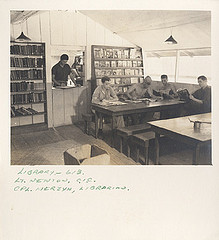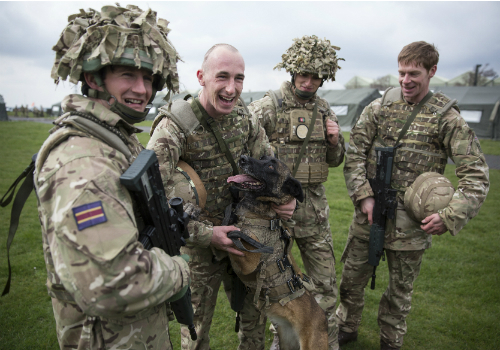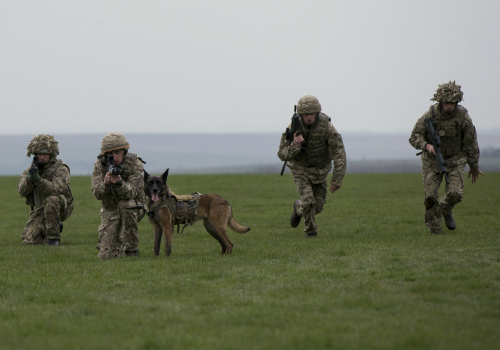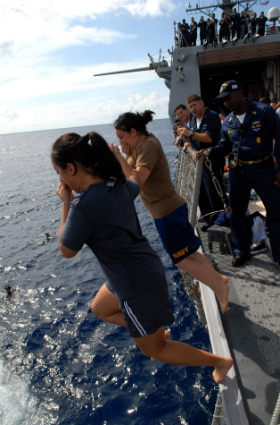Thomas E. Ricks's Blog, page 53
March 31, 2014
Using aircraft carriers as tethered goats?

Here's a novel argument: Using today's carriers as intentionally big
fat targets. "Washington might try to use carriers for
deterrence despite or even because of their vulnerability. The purpose would be
to signal America's willingness to raise the stakes."
You see, the
vulnerability of 1960s-style carriers is one of their strengths. Right? Sign up
to be a crew member right here.
Memorable military names

I didn't
know that there was a Royal Navy admiral named Reginald Plunkett-Ernle-Erle-Drax. He fought at Dogger Bank.
Looking that up the other day, I noticed something else I
didn't know, which was that during the last ice age, when Dogger was dry land,
the Thames and the Rhine had a common mouth, or at least what looks like one in this map.
March 28, 2014
The seven steps of highly effective counterinsurgents: A new RAND guide

There are seven
steps usually seen in negotiating an end to an insurgency, according to a new RAND
study, "From Stalemate to Settlement." It looks at Northern Ireland, the Philippines,
Lebanon, Western Sahara, Mozambique, Indonesia, Kampuchea, Bosnia, Tajikistan,
Burundi, Chechnya, and Congo. Only in one case were the seven steps followed
exactly in the sequence here, the study says, but "each case unfolded in a
manner close enough to this narrative that it is a useful comparative tool for
understanding how to reach negotiated settlements."
Those steps are:
Military stalemate
Acceptance of
insurgents as legitimate negotiating partners
Brokered
cease-fire (not always respected)
Official
intermediate agreement
Power-sharing
offer (or other concession, such as amnesty or elections)
Moderation of
insurgent leadership
Third-party
guarantor
Some Army War College bibliographies: Cyber, U.S. military history, officership

AMERICAN MILITARY HISTORY
The purpose of this bibliography is to introduce some
of the resources readily available in our Library's collection on
American Military History. Topics include
the importance of history, doctrine, strategy, and tactics, lessons learned, rules of engagement and law of war,
transformation and reform, and pathways to additional historical information.
http://www.carlisle.army.mil/library/bibs/american_military_history.pdf
CYBERSPACE
Contains resources discussing cyber acts of war, the
battlespace of the fifth domain, governance, jurisdiction, policy,
security, strategy, and technology that is currently being employed.
http://www.carlisle.army.mil/library/bibs/Cyberspace2013.pdf
OFFICERSHIP AND THE PROFESSION
Includes references for readings on career path,
education, civil-military relations, mentorship, and other topics directly
related to the study of Officership and the Profession.
http://www.carlisle.army.mil/library/bibs/Officership2013.pdf
These bibliographies and others compiled by our
research librarians are available online through the Library's home page at
http://usawc.libguides.com/bibliographies
Rebecca's War Dog of the Week: British Army Unveils New Elite Force (with Dogs)

By Rebecca Frankel
Best Defense Chief Canine Correspondent
The British Army just debuted its new elite fighting force
-- the Force Troops
Command (FTC). Soldiers from the new wing offered a preview of their
specialist capabilities in a series of demonstrations this week at Upavon
Airfield which included "infantrymen, divers, medics, artillery units,
missile specialists, chefs," and, yes, dog teams.
Handlers like Private Terry Gidzinski and his MWD Cheyenne
(pictured above) were there to show off their skills. In this photo, the pair
is relaxing, but in the photos below Gidzinski and Cheyenne (along with
Corporal Kelly Wolstencroft and her MWD partner Tran) are demonstrating their
teams' capabilities -- what I would guess would be combat-ready tactical drills
and bite work (though the photo captions don't specify).
According to the British Army website, FTC will be fully
operation as of April 1 and will eventually be composed of "nine 'functional' brigades" including:
A new Intelligence and
Surveillance Brigade will deliver integrated intelligence surveillance and
reconnaissance capabilities, drawing specifically on lessons from Afghanistan.
A new Artillery Brigade will deliver both close support artillery and precision
fires, as well as leading Air-Land Integration. 8 Engineer Brigade will expand
to command the close support engineer units, as well as Explosive Ordnance
Disposal and Search, Force Support and Infrastructure Groups.
So, the war-dog takeaway? The British Army appears to be
readying itself to put to (perhaps even better) use the lessons of Afghanistan,
meaning that it fully anticipates engaging an enemy in asymmetric warfare.
Which means IEDs -- as JIEDDO head Lt. Gen. Michael D. Barbero called them in 2012, the
"weapon of choice by threat networks" for decades to come. Which
means, of course, explosive-detecting dog teams are going to come in handy.


March 27, 2014
An actuary looks at the Future of War (no. 22) -- and sees a nuclear war looming there

By
Matt Wilson
Best Defense
future of war entry
It's been almost 70 years since a great-power war, and war in general is
declining. What does this mean concerning the future of war?
Imagine an area that historically has gotten
a large earthquake about every 20 years. However, it hasn't had an earthquake
in over 60 years. Should you be worried?
It turns out the basic processes moving
societies into the future and the earth's crust into future are similar. The future
heavily builds on the past -- a positive feedback loop process. All positive
feedback processes that are stabilized (not allowed to crash) will experience a
very large crash at some point in time. And if a very large crash is still
suppressed, then the system (society or earth) will get stuck in the middle of
a phase change. When the system finally undergoes a phase change, then
everything will get wiped out. What happens when you put out every forest fire?
Forests follow the same positive feedback loop process too. In the meantime,
the system will sit at the edge of a cliff, unable to move forward very well.
This explains Japan's economy and now the U.S. economy too. It also explains the future of war: the
large crash.
Time of stability is the biggest factor in
determining when a system is nearing a crash state. After a long period of
stability, a big problem in one area implies that big problems are lurking
elsewhere. The 9/11 shock in 2001 was our first sign of trouble. The 2008
financial crisis pushed the United States into a pre-collapse state that is
being suppressed. Like Japan, the United States will not be able to get going
again until it allows another great depression. The next shoe to drop could be
a great-power nuclear war. Look at the connection between financial crisis and
war:
1. The 1907 U.S. financial crisis was
followed by World War I in 1914.
2. The 1929 U.S. financial crisis was
followed by World War II in 1939.
3. The 2008 U.S. financial crisis was
followed by World War III in 2015-2018?
The same build-up of problems that caused a
financial crisis also positioned societies for war. Those problems are a build-up
of bad ideas, bad decisions, and corruption. They build up within all sectors
of society at about the same rate. So the fact that the financial sector is mostly
independent of the military sector is irrelevant. A big crisis in one area just
tells us that time is up.
You and everyone else you know think that a
great-power nuclear war is just about impossible.
In fact, it just might be the future of war.
Matt Wilson is a retired actuary who blogs on
emerging risks. Interested parties can find more information about the concepts
discussed in this article: "
A System
Collapse Framework for Societies
." "Controlled instability is
your friend." Marinate on that.
Tom note: OK,
we're at number 22, but interesting ideas are still pouring in. Got one?
Consider submitting an essay
. The contest remains open for at least another week. Try to
keep it short -- no more than 750 words, if possible. And please! no footnotes
or recycled war college papers.
Comment of the day: The real reasons one Army officer is bailing out of the military

I liked this comment yesterday from the over-educated, eloquent "Kieselguhr Kid" in
response to the article about Navy officers leaving:
OK, so as a junior-to-midgrade officer in the process of dropping
out, I'm hating this article. It contains all the wrong ideas and I hear them
all the time anyway -- it reflects the institutional mindset of the brass.
First thing: worry less about how to get me more money and
education and crap. We became junior officers in wartime because we wanted to
do meaningful work for our country. I had a job offer worth over six times my
starting salary as an officer (indeed, I emailed the offer letter to my AOC
consultant because he was taking forever to get me to officer basic). I didn't
sign up for the perks. I signed up for the mission.
I'm quitting because I don't believe any more that my senior
officers give a crap about the mission. Every time -- every single time --- I
have met with one, I hear about what moves and positions are good for my career
progression, just like the article here seems to be worried about. Screw that. Tell
me what positions I can make a positive difference in. And lead by example,
dammit.
How about the military starts acting like servants of the
people, and good caretakers of its enlisted? Those two things and you'll get
all the junior officers you need to stay in.
Disturbing odd trends of the day: Iraqis murdered in Libya, Finns fighting in Syria, and DIA former Soviet states job open

Someone
is killing Iraqi professors working in Libya. Then there are the Finnish jihadists in Syria.
Can't we
all just get along?
In other
weird news, the job of overseeing Eurasia military intelligence
(that is, former Soviet states) is open at DIA. Interesting time to have that job vacant. A
friend asks, "I
wonder if the guy was planning on leaving, or if he made the wrong call on
Ukraine and was held to account."
March 26, 2014
Ann Scott Tyson's astonishing new account of an SF officer in Afghanistan

You
can work alongside someone for years and not really know them, what they think,
what is going on inside their lives.
That
thought hit me repeatedly as I read the first 30 pages of Ann Scott Tyson's American Spartan: The Promise, the Mission and the Betrayal
of Special Forces Major Jim Gant. I didn't know about her deep depression, her
marriage breaking up, or her romance with and marriage to a Special Forces
officer. (BTW, she is the third journalist who is a female graduate of Harvard
I know who wed an SF officer. They should form a special society.) Nor did I
know that she took solace in the works of Homer, as I did a few years earlier
when trying to figure out war and coming home from it. For a year, I drove to
and from work every day listening and re-listening to The Odyssey, read by Ian McKellen.
I
suspect this book will be read a lot longer than most books about the American
war in Afghanistan. It especially will resonate with people interested in Special
Forces.
It
seems to me that we need people like Gant to do real foreign internal defense.
But do we have a military that can live with its officers "going native"? If
not, can we really do FID?
As for bringing along
your girlfriend and training her in weapons: A new model for Special Ops?
People talk about thinking outside the box and then freak out when
confronted by it.
Admiral, we need to talk! Officer's white paper on JOs jumping ship warns Navy's leadership of heavy personnel seas ahead

By Capt. Herb Carmen,
U.S. Navy
Best Defense guest
columnist
Earlier
this month, Cmdr. Guy "Bus" Snodgrass wrote a 24-page white paper titled "Keep a Weather Eye on the
Horizon: A Navy Officer Retention Study." He describes current trends
in naval officer retention with historical context of earlier cycles of retention
challenges. He also provides recommendations to address what he observed as a
"tipping point" in officer retention. He explains that high operational tempo,
plummeting morale, and an improving economy outside defense are factors leading
to historically low retention numbers in the junior officer ranks and a
dramatic increase of squadron commanders who retire after their command tours
rather than continue to serve as captains.
Cmdr.
Snodgrass's recommendations include improving communications from senior
leadership to commanding officers, reinstating additional payments for high op-tempo
sailors and commanding officers, changes in promotion and selection processes,
and other ideas worth considering. Snodgrass's white paper is well-written, and
thoughtful. Most importantly, it has sparked a much-needed conversation on
officer retention.
While
Cmdr. Snodgrass probably never intended his paper to go all viral in the Navy,
it has. After making its way across the fleet via email -- passed down by type
commanders to strike groups and air wings -- it was posted on the Naval
Institute Blog, multiple informal military-related email groups external to the
Navy, and the online discussion forum Sailor Bob, an informal website for
active-duty and retired Naval officers. On Sailor Bob alone, it has received
over 7,100 views and more than 257 comments as of this writing. It has spread
across service boundaries on Facebook. As I was drafting this post, Vice
Admiral Bill Moran, chief of naval personnel, wrote about Cmdr. Snodgrass's
paper and encouraged others to share their own ideas.
One of
the reasons that the white paper has enjoyed such reach among senior leadership
is that he explains issues, historical context, and recommendations without
snark, bitterness, or complaint. He also uses data. In fact, his numbers are so
current and relevant that I felt compelled to reach out to "Bus." I asked him
directly, "Did you get these numbers from the Bureau?" He had, directly from
the community managers whose job it is to track the numbers and flow of
personnel through specific warfare communities. What Cmdr. Snodgrass has
written is a gem: real numbers, solid research, and a clearly articulated
argument.
The
numbers are striking. Less than 35 percent of surface warfare officers are staying
in the Navy after their minimum service requirement (MSR). Just 36 percent of eligible
aviation officers are taking the department head retention bonus to remain in
service through the O-4 milestone tour. In 2013, a record number of special
warfare lieutenants declined to remain in service for the next promotion. Perhaps
more telling is a chart that shows a dramatic increase in the number of
post-command commanders choosing to retire following their command tours (five
in FY09 and 23 in FY14). While Cmdr. Snodgrass provides some historical context
to retention cycles, Cpt. Michael Junge's Aug. 2012 Proceedings article, "Generational Change and the 'Stay-or-Go' Question," provides historical context on retention challenges and
generational differences dating back to the 1950s.
Vice
Admiral Moran notes that naval leaders are aware of several of the issues that Cmdr.
Snodgrass raises, "Many are being studied, budgeted for, or in the early stages
of implementation. Others give us pause." Two observations in Cmdr. Snodgrass's
paper concern Vice Admiral Moran, "The idea that there is a perception that
operational command is not valued and there is an erosion of trust in senior
leadership bothers me ... I want to hear more, learn more from you."
It's no
wonder that Vice Admiral Moran is concerned. Command and trust are at the heart
of naval service. Naval officers grow in a culture where the pinnacle of a
naval career is command and trust in senior leadership is critical to success
as a commanding officer. Officers who achieve command as an O-5 often look back
at their command tour as the most rewarding in their careers. Those who achieve
that milestone are chosen from the best and brightest in their warfare
communities. They also represent the seed corn for major command as captains
and, eventually, for flag officer selection. While these officers have earned
the coveted roles as commanding officers, and the Navy sees these officers as
most fit to serve in command, those who retire following command take a great
deal of irreplaceable experience with them when they leave. As Snodgrass notes,
"The Navy, unlike its private sector
counterparts, cannot hire department heads, commanding officers, or senior officers
from outside the service -- we promote from within. We need high retention
rates to ensure the health of the service."
In his
summary, Cmdr. Snodgrass captures the current state of retention and the
effects that falling officer retention will have on enlisted sailors:
...officer retention is at a
tipping point where events from our past, present, and anticipated near-term
future are coalescing to negatively impact retention. In short order, we will
begin losing a large number of officers with more than a decade of operational
wartime experience, and they'll be taking their expertise and lessons learned
with them. While their qualifications can be replaced, their experience cannot.
This trend is also likely to impact our enlisted ranks because of the
significant negative impact plummeting junior-, mid-, and senior-grade officer
retention can have on the enlisted members within their commands.
The
first recommendation Cmdr. Snodgrass offers is to improve communication from
leadership to commanding officers to provide relevant current information to
the deckplates and to ensure the fleet understands the course the Navy has set.
Some of the feedback to the paper suggests that this communication must go well
beyond personnel and career issues. There is a widely held perception that the
Navy does not have a coherent strategy of where it is going in 2014 or where it
wants to be in 2030. A clear understanding of the Navy's mission is essential. As
Cmdr. Snodgrass points out, "...a belief in the importance of their unit's
mission is critically important to those surveyed for this white paper and is a
significant factor positively impacting retention."
To
retain officers through and beyond their command tours, Cmdr. Snodgrass
recommends permanently reinstating the critical skills bonus for commanding
officers. There is some debate whether this should be offered, suggesting that
others would be willing to serve in command without the bonus. Another point of
view is that those who chose to retire after command were chosen based on their
performance and should be allowed to retired after command if they so choose. The
differences in opinions highlight the reality that each individual has a unique
set of factors that go into the decision of whether to stay in or leave
service.
Another
recommendation Cmdr. Snodgrass offers is to move milestone-screened officers up
the lineal list to the top of their respective year groups. I offered a similar idea on the blog Information
Dissemination in 2011, suggesting that the lineal list be restacked after each
promotion board based on the board's confidence rating. We need to be willing
to modify the lineal list and give officers who consistently perform better
than their peers an opportunity to promote faster, based on recent performance
rather than how they compared to their peers on the day they joined.
Generational
differences are also at play. Cmdr. Snodgrass points to studies that find
differences in what motivates Millennials and non-millennials in the job
market: feeling supported and appreciated and having development opportunities.
He hits the nail on the head when he discusses the importance of development
through education, "The Navy must find a way to provide greater educational
opportunities to its warfighters. The CNO's Diversity Vision puts it best, stating
the Navy needs sailors 'diverse in background, experience, and ideas' to reach
our full potential as a warfighting force." Today's officer career paths have become overly scripted.
Those who stray from the prescribed path -- even for one tour -- risk not
screening for the next career milestone. We need to reward those who perform
well in important jobs and seek out advanced degrees, even if a particular job
or degree does not appear on the recommended path. When we consider an officer
for the next milestone, screen boards should also look at the officer's
potential contribution well beyond the milestone at hand.
According
to Cmdr. Snodgrass, "Millennials place a high premium on advanced education,
especially an in-residence degree from a civilian institution." He recommends
incentivizing education opportunities within career paths to support professional
development. He also mentions that the post-9/11 GI Bill inadvertently creates
an incentive to leave naval service to pursue advanced education.
This
incentive was created in 2012 when the post-9/11 GI Bill was modified by law. Prior
to 2012, active-duty members received 100 percent of tuition and fees. The
change placed active-duty personnel under the same tuition caps as other veterans
without providing active-duty eligibility for the Yellow Ribbon Program that other veterans enjoy. Today,
a veteran receives significantly more support than an active-duty servicemember
when using the post-9/11 GI Bill, thus creating an incentive to separate to
obtain an advanced education. I recommend making active-duty personnel eligible
for the Yellow Ribbon Program. Additionally, I recommend that the services
consider paying the balance of tuition, books, and fees after all other
eligible benefits (including Yellow Ribbon participation) are applied in return
for a reasonable service obligation. This could offer a retention incentive and
provide an economical way for the department to educate its officers at some of
the nation's best civilian universities.
Another
factor, which deserves at least equal consideration, is how family
considerations, including employment trends for spouses, play a crucial role in
the retention calculus. Cpt. Junge's article provides a worthy
recommendation: Bring back the annual Junior Officer Survey, which was
discontinued after 2008. We should not stop there. We should publicize the
aggregated results of this survey (and other Navy-funded surveys of personnel)
to add transparency and allow commanding officers to see and understand the
most relevant factors that motivate officers and drive retention.
We
shouldn't rely on internal, DOD-funded studies alone to help guide the way. Data
and findings from Blue Star Families's annual Military Lifestyle Survey, which includes thousands of
respondents each year, provides a broad picture of the issues affecting the
satisfaction of military families and the motivations for service.
If the
Navy wants to take a proactive approach to understanding the motivations for
officer retention, it should look closely at spouse
employment. The
Navy has a higher percentage of officer spouses
in civilian employment than any other service and a spouse's career is a major factor in
retention. Data in the 2012 American Community Survey show that military spouses
make 38 percent less than their civilian counterparts. Meanwhile, the Pew
Research Center shows that Millennial women are more likely to have a
bachelor's degree than their male counterparts and now begin their careers at
near parity with men. If military service is seen as having a negative impact
on a spouse's earnings, it may have a greater bearing on an officer's decision
to remain in service.
While Cmdr.
Snodgrass describes many of the factors affecting retention, he could not
possibly cover them all in a single white paper. Nor was that his intent. Instead,
he wanted these issues to be known, discussed, and addressed. He's accomplished
that goal, but the discussion needs to continue. I recommend reading Cmdr.
Snodgrass's paper and adding to the discussion. Vice Admiral Moran's "green
light" to bring ideas forward is an encouraging endorsement to continue the dialogue
in light of the risks officers who write
often face. It is
also an important signal of trust.
Captain Herb Carmen is an
E-2C Hawkeye and C-2A Greyhound pilot who previously commanded the VAW-116
"Sun Kings." He is a graduate of the U.S. Naval Academy and
Georgetown University's McDonough School of Business, and also a former senior
military fellow at the
Center for a New American Security.
The opinions and views expressed in this post are Cpt. Carmen's
alone and are presented in his personal capacity. They do not necessarily
represent the views of U.S. Department of Defense, the U.S. Navy, or any other
agency.
Thomas E. Ricks's Blog
- Thomas E. Ricks's profile
- 437 followers



